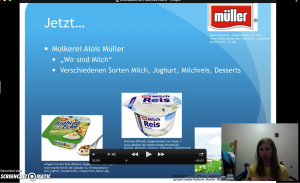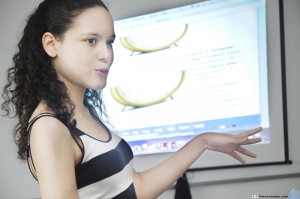Student presentations are commonplace in world language classrooms and have been for a long time. Teachers use them for all the right reasons: instruction moves from teacher-fronted to student-centered, students gain responsibility for course content, and learners practice ACTFL’s presentational mode of communication. Presentations offer a possibility to assign research outside the classroom to students, whether at the library, in the form of interviews, or on the Internet to train associated academic skills. In 16 years of teaching, I have used a wide variety of presentations in almost every class ranging from one student presenting on an assigned topic, to groups of students presenting on a self-chosen topic related to the course content.
In my own classes as well as those I observe as a supervisor of student teachers, presentations are always part of a larger project using a process approach. Students, alone, in pairs or in groups, sign up for a presentation date. Topics for these presentations either are assigned or discussed with the teacher. In line with best practices, teachers discuss a rubric designed to assess students’ performances at the beginning establishing expectations for the project. Students’ awareness of the teacher’s expectations for the project provides them with clear guidelines and goals that will help them to focus their efforts. Following the establishment of expectations, students start researching their topic in venues such as the school library or using Internet sources. Setting aside class time to research in a computer lab or at the library allows teachers an opportunity to guide students and to ensure more thoroughly researched presentations. Having students work through a timeline with benchmarks along the way such as submitting an outline, identifying photos or media to include, and the final slideshow such as Prezi, PowerPoint, Google Slides or a poster to allow teachers to provide feedback prior to the in-class performance is a helpful strategy. The hope of these preliminary steps is to guide students through a thorough preparation process that will ensure the best possible outcome.
To avoid that glazed-over look from the student audience, it is important to develop a listening task during the performance. That task may be a set of questions to complete based on listening to the presentation or for listeners to write 3 of their own follow up questions to ask. These tasks capture students’ attention toward the most important elements of a presentation. It also provides a formative assessment of peer comprehension of the presentation.
Over the course of the past year, I have paid particular attention to identifying ways to use technology in order to change how students prepare for in-class presentations. My personal philosophy for integrating instructional technology stems from the question: Does the addition of instructional technology add an element to teaching and learning that I otherwise could not accomplish? I have explored various apps and computer-based programs to improve student presentations. Presentational Communication by definition is rehearsed practiced speech yet one consistent struggle is the lack of practice on behalf of students. Using a web-application called Screencast-o-Matic has improved the quality of students’ presentations in my classes markedly. Screencast-o-Matic is available free of charge, works on PCs and Macs, can be used when online or offline, and is very user-friendly. The University of  Wisconsin Stevens Point offers an easy to follow tutorial that eliminates the use of class time to train students. My favorite feature of this particular program is the ability to capture the presentation on the computer screen while recording a student’s presentation in a separate window.
Wisconsin Stevens Point offers an easy to follow tutorial that eliminates the use of class time to train students. My favorite feature of this particular program is the ability to capture the presentation on the computer screen while recording a student’s presentation in a separate window.
The resulting video files can be saved in multiple formats and easily shared with others. In an effort to take advantage of the sharing feature, my students are assigned to a partner. Partners provide feedback regarding comprehension and content based on viewing the screencast. Experience indicates that if students understand their peer’s presentation and are given this low stakes opportunity to clarify confusion with a classmate, their overall performance improves. In addition, this practice introduces a second student, who can answer questions about the content of the presentation.
Overall, screencasting offers wonderful benefits to instruction, if access to this technology is available. First, the overall quality of presentations often improves due to required practice before it counts. This step may also lead to better comprehensibility by the class since presentations are of a higher quality; repeated practice of presentations leads to increased fluency and confidence by the presenter. Second, other students become involved in the preparation of the presentation. The feedback provided by a peer offers an indication of the overall comprehensibility of the presentation allowing the creator an opportunity to revise and improve their work. Third, these recordings allow the instructor to offer more detailed assessment, a more concrete evaluation of students’ language performance. By watching the recording together, it’s easier to point out systemic problems in pronunciation, syntax and content. These screencasts provide an ideal tool to support student growth in proficiency while adding an element to my teaching that was not at my disposal when I first started my career.


